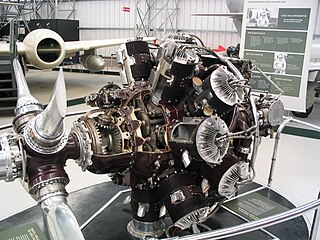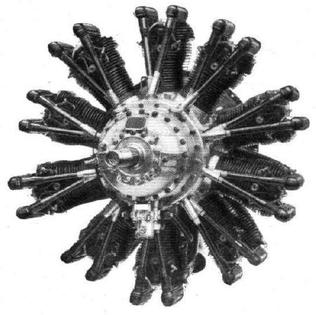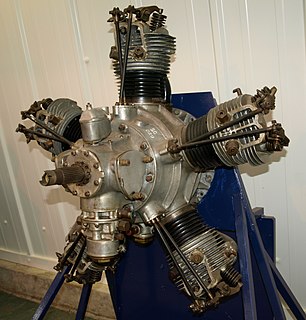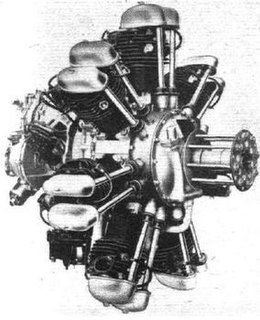
The Bristol Pegasus is a British nine-cylinder, single-row, air-cooled radial aero engine. Designed by Roy Fedden of the Bristol Aeroplane Company, it was used to power both civil and military aircraft of the 1930s and 1940s. Developed from the earlier Mercury and Jupiter engines, later variants could produce 1,000 horsepower (750 kW) from its capacity of 1,750 cubic inches by use of a geared supercharger.

The Bristol Hercules was a 14-cylinder two-row radial aircraft engine designed by Sir Roy Fedden and produced by the Bristol Engine Company starting in 1939. It was the most numerous of their single sleeve valve designs, powering many aircraft in the mid-World War II timeframe.

The Armstrong Siddeley Cheetah is a seven-cylinder British air-cooled aircraft radial engine of 834 cu in capacity introduced in 1935 and produced until 1948. Early variants of the Cheetah were initially known as the Lynx Major.

The Armstrong Siddeley Jaguar was an aircraft engine developed by Armstrong Siddeley. The Jaguar was a petrol-fuelled air-cooled 14-cylinder two-row radial engine design. The Jaguar III was first used in 1923, followed in 1925 by the Jaguar IV and in 1927 by the Jaguar VI. In 1925 the Jaguar became the first production aero engine incorporating a geared supercharger.

The Armstrong Siddeley Panther was a 27-litre 14-cylinder twin-row air-cooled radial aero engine developed by Armstrong Siddeley. It was originally named the Jaguar Major.

The Armstrong Siddeley Lynx is a British seven-cylinder aero engine developed by Armstrong Siddeley. Testing began in 1920 and 6,000 had been produced by 1939. In Italy Alfa Romeo built a 200 horsepower (150 kW) licensed version of this engine named the Alfa Romeo Lynx.

The Armstrong Siddeley Mongoose is a British five-cylinder radial aero engine produced by Armstrong Siddeley. Developed in the mid-1920s it was used in the Hawker Tomtit trainer and Parnall Peto seaplane amongst others. With a displacement of 540 cubic inches (9 litres) the Mongoose had a maximum power output of 155 horsepower (115 kilowatts).
The Bristol Hydra was an experimental 16-cylinder, twin-row radial aircraft engine built by the Bristol Engine Company. It is a relatively rare example of a radial with an even number of cylinders per row – it is often claimed that radial engines require an odd number of cylinders, but this is simply easier, not physically required. Only two Hydras were built, the type never entered production.
The Bristol Draco was an air-cooled nine-cylinder radial engine from the British manufacturer Bristol Aeroplane Company. It was essentially a version of their famous Pegasus converted to use a fuel injection system.

The Armstrong Siddeley Serval was a British ten-cylinder aero engine developed by Armstrong Siddeley in the late 1920s. Following company tradition, the engine was named for the serval.

The Armstrong Siddeley Genet Major is a British five-cylinder, air-cooled, radial engine for aircraft, designed and built by Armstrong Siddeley and first run in 1928. It developed 140 horsepower (104 kW). In Royal Air Force use the seven-cylinder version was known as the Civet I. The Feliform names used are in line with company convention, the Genet and Civet both being large cat-like carnivores.

The Armstrong Siddeley Genet was a five-cylinder, air-cooled, radial engine for aircraft use built in the UK, first run in 1926. It developed 80 hp at 2,200 rpm in its final form and was a popular light aircraft powerplant. Following the company tradition with a slight deviation the engine was named after the Genet, a catlike animal of the same order but different family.

The Bristol Titan was a British five-cylinder air-cooled radial engine, designed and built by the Bristol Aeroplane Company in the late 1920s. It had the same size cylinders as the earlier Bristol Mercury engine, 5.75 in x 6.5 in and produced between 200-240 hp. Later versions of the Bristol Titan also used a Farman-style reduction gear produced by Gnome-Rhône.

The Armstrong Siddeley Tiger was a British 14-cylinder air-cooled aircraft radial engine developed by Armstrong Siddeley in the 1930s from their Jaguar engine. The engine was built in a number of different versions but performance and dimensions stayed relatively unchanged. The Tiger VIII was the first British aircraft engine to use a two-speed supercharger.

The Siddeley Tiger was an unsuccessful British aero engine developed shortly after the end of World War I by Siddeley-Deasy. Problems encountered during flight testing caused the project to be cancelled.
The Armstrong Siddeley Hyena was a British aero engine developed by Armstrong Siddeley. Designed in the 1930s, it was an unusual experimental radial engine with inline cylinder banks. It was flown using an Armstrong Whitworth A.W.16 fighter aircraft as a test bed. Unresolved problems with cooling of the rear cylinders prevented the engine from going into production. Few details of this engine survive as company records were lost.

The Armstrong Siddeley Ounce was a small two-cylinder aero engine developed by Armstrong Siddeley in 1920. The engine was originally conceived as a test piece but ran very well and was put into production for early ultralight aircraft and use in target drones. The Ounce used two cylinders from the preceding Jaguar I radial engine.

The Bristol Neptune was a seven-cylinder air-cooled radial engine developed in 1930. It had the same size cylinders as the earlier Mercury and Titan engines, 5.75 in (146 mm) x 6.5 in (165 mm) which gave a displacement of 1,182 cu in and produced a maximum of 320 horsepower (239 kW). The Neptune was effectively a seven-cylinder version of the Titan.

The Wolseley Aquarius I or A.R.7 was a British seven-cylinder, air-cooled radial aero engine that first ran in 1933, it was designed and built by Wolseley Motors. Intended for the military trainer aircraft market few were produced, as Wolseley withdrew from the aero engine market in 1936.

The Wolseley Aries III or A.R.9 was a British nine-cylinder, air-cooled radial aero engine that first ran in 1933, it was designed and built by Wolseley Motors. Intended for the military trainer aircraft market few were produced as Wolseley withdrew from the aero engine market in 1936.
















